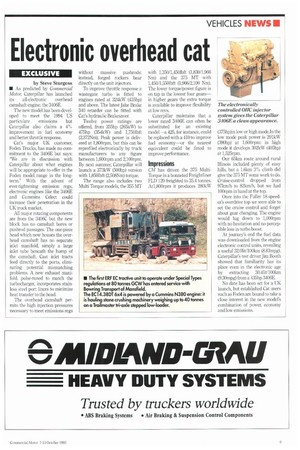Electronic overhead cat
Page 11

If you've noticed an error in this article please click here to report it so we can fix it.
EXCLUSIVE
by Steve Sturgess
• As predicted by Commercial Motor, Caterpillar has launched
its all-electronic overhead camshaft engine, the 3406E.
The new model has been developed to meet the 1994 US particulate emissions but Caterpillar also claims a 4% improvement in fuel economy and better throttle response.
Cat's major UK customer, Foden Trucks, has made no commitment to the 3406E but says: "We are in discussion with Caterpillar about what engines will be appropriate to offer in the Foden model range in the longterm." With the advent of ever-tightening emission regs, electronic engines like the 3406E and Cummins Celect could increase their penetration in the UK truck market.
All major rotating components are from the 3406C but the new block has no camshaft bores or pushrod passages. The one-piece head which now houses the overhead camshaft has no separate inlet manifold, simply a large inlet tube beneath the hump of the camshaft. Cast inlet tracts feed directly to the ports, eliminating potential mismatching problems. A new exhaust manifold, pulse-tuned to match the turbocharger, incorporates stainless steel port liners to minimize heat transfer to the head, The overhead camshaft permits the high injection pressures necessary to meet emissions regs without massive pushrocis: instead, forged rockers bear directly on the unit injectors.
To improve throttle response a wastegate turbo is fitted to engines rated at 324kW (435hp) and above. The latest Jake Brake 340 retarder can be fitted with Cat's hydraulic Brakesaver.
Twelve power ratings are offered, from 355hp (265kW) to 475hp (354kW) and 1,7501bft (2,372Nm). Peak power is delivered at 1,800rpm, but this can be reprofiled electronically by truck manufacturers to any figure between 1,600rpm and 2,100rpm. By next summer, Caterpillar will launch a 373kW (500hp) version with 1,8501bft (2,508Nm) torque.
The range also includes two Multi Torque models, the 355 MT with 1,350/1,45011)ft (1,830/1,966 Nm) and the 375 MT with 1,450/1,5501bft (1,966/2,100 Nm). The lower torque/power figure is on tap in the lowest four gears— in higher gears the extra torque is available to improve flexibility at low revs.
Caterpillar maintains that a lower rated 3406E can often be substituted for an existing model—a 425, for instance, could be replaced with a 410 to improve fuel economy—or the nearest equivalent could be fitted to improve performance.
Impressions CM has driven the 375 MultiTorque in a bonneted Freightliner FLD 120 freighted to 35.4 tonnes. At1,80Orpm it produces 280kW
(375hp)in low or high mode.In the low mode peak power is 291k1N (390hp) at 1,600rpm: in high mode it develops 302kW (405hp) at 1,525rpm.
Our 65km route around rural Illinois included plenty of easy hills, but a 1.6km 3% climb did give the 375 MT some work to do. Cruise-control dropped from 97km/h to 82km/h, but we had 100rpm in hand at the top.
Once into the Fuller 18-speeder's overdrive top we were able to set the cruise control and forget about gear changing. The engine would lug down to 1,000rpm with no hesitation and no perceptible loss in turbo boost.
At journey's end the fuel data was downloaded from the engine electronic control units, revealing a useful 32.01it/100km (8.83mpg). Caterpillar's test driver Jim Booth showed that familiarity has its place even in the electronic age by extracting 30AlitilOOkrn (9.30mpg) from a 435hp 3406E.
No date has been set for a UK launch, but established Cat users such as Foden are bound to take a close interest in the new model's combination of power, economy and low emissions.




























































































